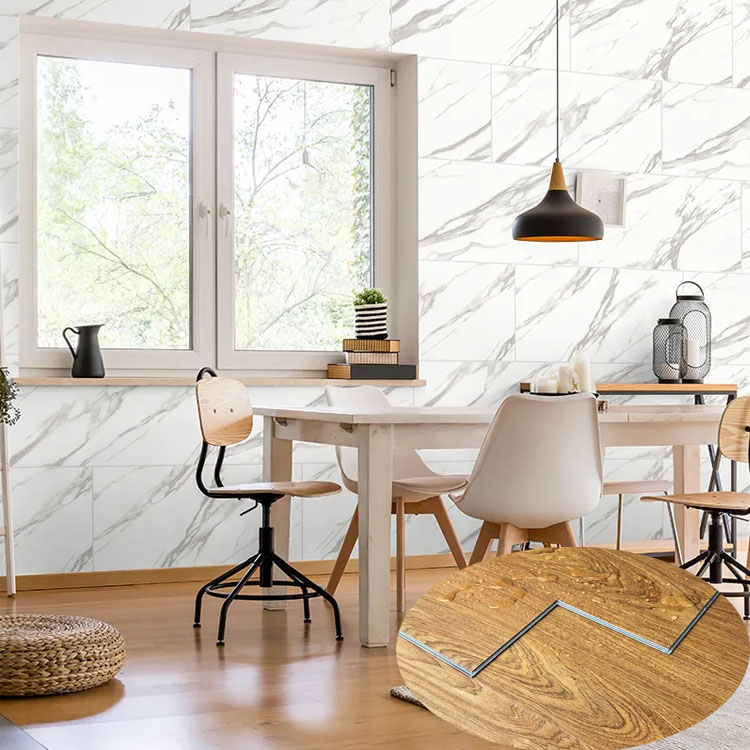SPC flooring (Stone Plastic Composite Flooring) as a popular flooring material, its durability and ease of maintenance make it the first choice for many homes and commercial establishments. However, when using SPC flooring, there are still some things to pay attention to to ensure its normal service life and maintain its beauty and performance. Here are some precautions to tell you about the installation steps and use of SPC flooring:

The installation of SPC floor (stone-plastic composite floor) is relatively simple, but it still needs to follow the correct steps to ensure the quality and effect of the installation. The following are the general installation steps for SPC flooring:
Preparation:
a. Clean the floor: Make sure the floor is flat, dry, clean and free of any debris or dust. Uneven floors can be repaired if necessary.
b. Check the floor humidity: Use a floor moisture tester to check the floor humidity to ensure it meets the SPC floor installation requirements.
c. Measurement and planning: Measure the size of the room and plan the installation method of the SPC floor, determine the direction and pattern of laying.
Install the subfloor: Install appropriate subfloor materials as required. The bottom layer provides vertical support, reduces noise and absorbs ground imbalances.

Lay the floor:
a. Pre-arrange the floor: Unpack the floor and allow the floor to acclimate to temperature and humidity in the room before installation. In order of installation, pre-arrange the floors to ensure an even distribution of colour, texture and size.
b. Lay the first row: Begin at a corner of the room wall, aligning the long edge of the floor with the wall. Use the installation origin tool to maintain the exact position of the floor. Make sure the floor has some gaps from the walls to allow for expansion and contraction.
c. Seam connection: Insert the next floorboard into the snap joint of the previous floorboard, pushing it in slowly in a horizontal direction. Use a rubber mallet to tap the floor lightly to make sure the snap joint is tight.
d. Cut the floor: Use a saw or tool to cut the floor to fit the shape of the room edges or around fixed objects, as needed. Make sure the cut floor fits and is secured securely.
Install Boundary and Transition Strips: Install boundary and transition strips at floor edges and transition areas as needed. These strips add to the aesthetics of the floor and provide edge protection and smooth transitions.

Cleaning and Maintenance:
a. Clean the floor: After the installation is complete, clean the floor thoroughly to remove dust and dirt created during the installation.
b. Maintenance Recommendations: Follow the SPC floor manufacturer’s recommendations for regular cleaning and maintenance of the floor to maintain its appearance and performance.
When undertaking an SPC floor installation, be sure to follow the specific installation guidelines and recommendations provided by the manufacturer to ensure proper installation methods and tools. If necessary, it is best to ask a professional installer to install it to ensure safety and quality.

Precautions for use:
Avoid flooding: Although SPC floors are water resistant, they still need to be protected from flooding. When cleaning, try to use a wet mop rather than a wet mop to reduce the chance of water accumulation. If water is splashed on the floor, it should be wiped dry immediately to prevent water from penetrating to the bottom of the floor and causing damage.
Prevent the impact of heavy objects: Try to avoid heavy objects directly hitting the surface of the SPC floor. When moving furniture or other heavy objects, floor surfaces should be protected with mats or soft pads to reduce scratches and damage.
Regular Cleaning: Regular cleaning is key to keeping your SPC floor looking and performing well. Use a soft-bristled brush or vacuum to remove dust and debris, and blot stains with a mild detergent. Avoid using too much water and acidic, solvent-based cleaners as they can damage the floor surface.
Avoid high temperature: SPC flooring is sensitive to high temperature, so avoid placing high-temperature objects directly on the floor, such as hot pots, kettles, etc. Use a mat or heat isolator to avoid direct contact, which could deform or damage the floor.
Watch out for furniture movement: When furniture needs to be moved, care should be taken to avoid scratching the floor surface. Furniture feet or rubber mats can be used to reduce friction and protect floors.
Avoid sharp objects: Avoid using sharp objects to scratch the surface of the SPC floor, such as steel wool, knives, etc. When moving items, try to avoid scratching the floor.
Protect from sun exposure: Prolonged exposure to direct sunlight can discolor and fade SPC floors. Use blackout curtains or blinds near windows to reduce sun exposure, or reposition furniture and rugs periodically to evenly distribute light.

In conclusion, following these usage precautions can prolong the life of your SPC floor and maintain its beauty and performance. If in doubt or for additional maintenance advice, it is advisable to consult the SPC flooring manufacturer or a professional.


